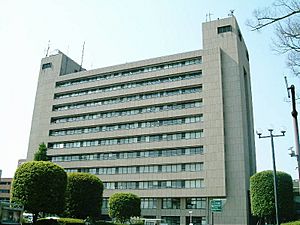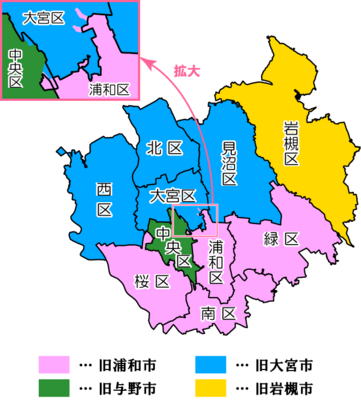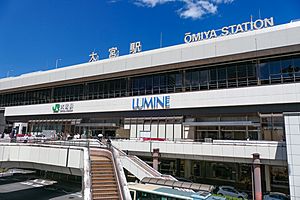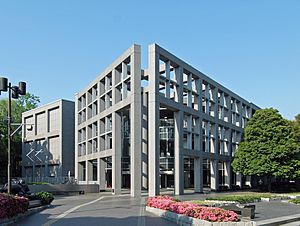Saitama (city) facts for kids
Quick facts for kids
Saitama
さいたま市
|
|||||||||||
|---|---|---|---|---|---|---|---|---|---|---|---|
| Saitama City | |||||||||||
![From top left: Saitama Stadium 2002, Urawa Parco [ja], Gyokuzouin [ja], Hikawa Shrine, Saitama New Urban Center, Saitama Super Arena, Musashi-Urawa Station](/images/thumb/e/ec/Saitama_city_montage.jpg/300px-Saitama_city_montage.jpg)
From top left: Saitama Stadium 2002, Urawa Parco, Gyokuzouin, Hikawa Shrine, Saitama New Urban Center, Saitama Super Arena, Musashi-Urawa Station
|
|||||||||||
|
|||||||||||

Location of Saitama in Saitama Prefecture
|
|||||||||||
| Country | Japan | ||||||||||
| Region | Kantō | ||||||||||
| Prefecture | Saitama | ||||||||||
| Area | |||||||||||
| • Total | 217.43 km2 (83.95 sq mi) | ||||||||||
| Population
(March 1, 2021)
|
|||||||||||
| • Total | 1,324,854 | ||||||||||
| • Density | 6,093.24/km2 (15,781.4/sq mi) | ||||||||||
| Time zone | UTC+9 (Japan Standard Time) | ||||||||||
| Phone number | 048-829-1111 | ||||||||||
| Address | 6-4-4 Tokiwa, Urawa-ku, Saitama-shi, Saitama-ken 330-9588 | ||||||||||
| Climate | Cfa | ||||||||||
|
|||||||||||
Saitama (さいたま市, Saitama-shi, pronounced [saꜜitama]) is the capital and largest city of Saitama Prefecture, Japan. Its area incorporates the former cities of Urawa, Ōmiya, Yono and Iwatsuki. It is a city designated by government ordinance. As of 1 February 2021[update], the city had an estimated population of 1,324,854, and a population density of 6,093 people per km² (15,781 people per mi²). Its total area is 217.43 square kilometres (83.95 sq mi).
Contents
Etymology
The name Saitama originally comes from the Sakitama District (埼玉郡) of what is now the city of Gyōda in the northern part of what is now known as Saitama Prefecture. Sakitama has an ancient history and is mentioned in the famous 8th century poetry anthology Man'yōshū. The pronunciation has changed from Sakitama to Saitama over the years.
With the merger of Urawa, Ōmiya, and Yono it was decided that a new name, one fitting for this newly created prefectural capital, was needed. The prefectural name "Saitama" (埼玉県) was changed from kanji into hiragana, thus Saitama City (さいたま市) was born. It is the only prefectural capital in Japan whose name is always written in hiragana, and belongs to the list of hiragana cities.
However, Saitama written in hiragana (さいたま市) actually finished in second place in public polling to Saitama written in kanji (埼玉市). Despite this, government officials decided to name the new city Saitama in hiragana, not kanji. In third place in the poll was Ōmiya (大宮市). In fourth was Saitama (彩玉市), written with an alternative kanji for sai (彩) which means "colorful". The sai (埼) used in the prefectural name is a rare form of a common character (崎) that means "cape" or "promontory".
Geography
The city is located 20 to 30 km north of central Tokyo, roughly at the center of the Kantō Plain. Situated in the southeast of Saitama Prefecture, the city is topographically comprised by lowlands and plateaus, at mostly less than 20 m above sea level, with no mountain ranges or hills within the city boundaries. The western portion of the city lies on the lowland created by the Arakawa River along with those created by small rivers such as the Moto-Arakawa River, Shiba River, and Ayase River. The rest of the area mostly resides on the Ōmiya Plateau lying in the north-south direction. Dispersed in this region, major rivers flow southward, almost paralleling to one another.
Surrounding municipalities
- Saitama Prefecture
- Ageo
- Asaka
- Fujimi
- Hasuda
- Kasukabe
- Kawagoe
- Kawaguchi
- Koshigaya
- Shiki
- Shiraoka
- Toda
- Warabi
Climate
Saitama has a humid subtropical climate (Köppen Cfa) characterized by warm summers and cool winters with light to no snowfall. The average annual temperature in Saitama is 15.2 °C (59.4 °F). The average annual rainfall is 1,371.3 mm (53.99 in) with September as the wettest month. The temperatures are highest on average in August, at around 27.0 °C (80.6 °F), and lowest in January, at around 3.9 °C (39.0 °F).
| Climate data for Saitama (1991−2020 normals, extremes 1976−present) | |||||||||||||
|---|---|---|---|---|---|---|---|---|---|---|---|---|---|
| Month | Jan | Feb | Mar | Apr | May | Jun | Jul | Aug | Sep | Oct | Nov | Dec | Year |
| Record high °C (°F) | 18.7 (65.7) |
25.5 (77.9) |
26.9 (80.4) |
31.2 (88.2) |
34.2 (93.6) |
38.0 (100.4) |
39.3 (102.7) |
38.7 (101.7) |
37.4 (99.3) |
33.1 (91.6) |
26.0 (78.8) |
25.1 (77.2) |
39.3 (102.7) |
| Mean daily maximum °C (°F) | 9.4 (48.9) |
10.3 (50.5) |
13.7 (56.7) |
19.2 (66.6) |
23.8 (74.8) |
26.5 (79.7) |
30.5 (86.9) |
31.8 (89.2) |
27.7 (81.9) |
21.9 (71.4) |
16.5 (61.7) |
11.7 (53.1) |
20.3 (68.5) |
| Daily mean °C (°F) | 3.9 (39.0) |
4.9 (40.8) |
8.4 (47.1) |
13.7 (56.7) |
18.6 (65.5) |
22.0 (71.6) |
25.9 (78.6) |
27.0 (80.6) |
23.2 (73.8) |
17.5 (63.5) |
11.4 (52.5) |
6.2 (43.2) |
15.2 (59.4) |
| Mean daily minimum °C (°F) | −1.1 (30.0) |
−0.2 (31.6) |
3.3 (37.9) |
8.4 (47.1) |
13.9 (57.0) |
18.3 (64.9) |
22.2 (72.0) |
23.2 (73.8) |
19.5 (67.1) |
13.5 (56.3) |
6.8 (44.2) |
1.2 (34.2) |
10.8 (51.4) |
| Record low °C (°F) | −9.8 (14.4) |
−8.8 (16.2) |
−5.0 (23.0) |
−2.0 (28.4) |
4.8 (40.6) |
11.5 (52.7) |
14.7 (58.5) |
16.3 (61.3) |
9.5 (49.1) |
3.6 (38.5) |
−2.4 (27.7) |
−6.7 (19.9) |
−9.8 (14.4) |
| Average precipitation mm (inches) | 42.4 (1.67) |
39.6 (1.56) |
88.0 (3.46) |
101.9 (4.01) |
121.4 (4.78) |
144.8 (5.70) |
148.0 (5.83) |
164.0 (6.46) |
202.8 (7.98) |
196.8 (7.75) |
70.9 (2.79) |
45.2 (1.78) |
1,371.3 (53.99) |
| Average precipitation days (≥ 1.0 mm) | 3.8 | 4.6 | 8.7 | 9.0 | 10.0 | 11.6 | 11.8 | 8.8 | 10.8 | 10.0 | 6.7 | 4.4 | 100.8 |
| Average dew point °C (°F) | −5 (23) |
−4 (25) |
1 (34) |
8 (46) |
13 (55) |
18 (64) |
22 (72) |
23 (73) |
19 (66) |
12 (54) |
6 (43) |
−1 (30) |
9 (49) |
| Mean monthly sunshine hours | 201.4 | 186.4 | 186.6 | 187.1 | 185.3 | 128.4 | 152.5 | 181.9 | 135.6 | 135.1 | 156.6 | 181.1 | 2,018 |
| Source 1: Japan Meteorological Agency | |||||||||||||
| Source 2: Time and Date (dewpoints, 1985-2015) | |||||||||||||
Demographics
Per Japanese census data, the population of Saitama has increased steadily over the past century.
| Historical population | ||||||||||||||||||||||||||||||||||||||||||||||||||||||||||||||||||||||
|---|---|---|---|---|---|---|---|---|---|---|---|---|---|---|---|---|---|---|---|---|---|---|---|---|---|---|---|---|---|---|---|---|---|---|---|---|---|---|---|---|---|---|---|---|---|---|---|---|---|---|---|---|---|---|---|---|---|---|---|---|---|---|---|---|---|---|---|---|---|---|
|
|
|||||||||||||||||||||||||||||||||||||||||||||||||||||||||||||||||||||
Wards
Saitama has ten wards (ku), which were assigned official colors as of April 2005:
| Wards of Saitama | |||||
|---|---|---|---|---|---|
| Place name | Map of Saitama | ||||
| Rōmaji | Kanji | Color | Area (km2) | ||
| 1 | Chūō-ku | 中央区 | ■ (rose red) | 8.39 | |
| 2 | Iwatsuki-ku | 岩槻区 | ■ (ochre) | 49.17 | |
| 3 | Kita-ku | 北区 | ■ (dark green) | 16.86 | |
| 4 | Midori-ku | 緑区 | ■ (green) | 26.44 | |
| 5 | Minami-ku | 南区 | ■ (lemon yellow) | 13.82 | |
| 6 | Minuma-ku | 見沼区 | ■ (sky blue) | 30.69 | |
| 7 | Nishi-ku | 西区 | ■ (blue) | 29.12 | |
| 8 | Ōmiya-ku | 大宮区 | ■ (orange) | 12.80 | |
| 9 | Sakura-ku | 桜区 | ■ (cherry blossom pink) | 18.64 | |
| 10 | Urawa-ku | 浦和区 | ■ (red) - administrative center | 11.51 | |
History
The city was founded on May 1, 2001, and was designated on April 1, 2003 as a government ordinance. For the histories of Urawa, Ōmiya and Yono before the merger, see:
- Urawa-ku, Saitama
- Ōmiya-ku, Saitama and
- Yono, Saitama, respectively.
On April 1, 2005, Saitama absorbed the city of Iwatsuki to its east, which became a new ward, Iwatsuki-ku.
Economy
Saitama's economy is principally constituted by commercial business. The city is one of many commercial centers of the Greater Tokyo area and serves Saitama Prefecture, North Kanto, and northeast Honshu.
Saitama is also home to various manufacturers, exporting automotive (Honda manufactures the Honda Legend at Sayama Plant), food, optical, precision and pharmaceutical products. Calsonic Kansei, a global automotive company is headquartered in the city. Iwatsuki is famous for manufacturing of hinamatsuri dolls and ornate kabuto (samurai helmets).
Land use
The political and administrative center of the city is Urawa Ward (Urawa Station area), and the economic, commercial, and transportation center is Omiya Ward (Omiya Station area). Located approximately 20 km to 35 km from central Tokyo, Saitama City is a satellite city and bed town in the Tokyo metropolitan area, with a day-night population ratio of 92.8 in 2010, which is less than 100 despites being the prefectural capital and an ordinance-designated city (the southeastern part of Saitama Prefecture).
Of the 747,000 commuters permanently residing in the city, 175,000, or 23.5%, commute to the Tokyo Special Wards area, making the city home to many so-called "Saitama Tomin". On the other hand, the former Urawa and Omiya cities were designated as core business cities in 1988, and in 2000, Saitama New Urban Center was opened and local branches of various central government offices were relocated from Tokyo. The southeastern area of Saitama Prefecture tends to be a suburb of Tokyo, and the day/night population ratio is particularly low in Minami ward and Midori ward, which are close to the center of Tokyo. In part for this reason, the southern part of the city, which is closer to Tokyo, tends to have a higher population density than the northern part. In addition, population tends to be concentrated along the Keihin Tohoku Line, Utsunomiya Line, Takasaki Line, and Saikyo Line, which directly connect to central Tokyo, and where both conditions overlap, there is a series of high population density areas of over 20,000 people/km2 from Minami ward to Urawa and Chuo ward.
Urban functions such as administration, commerce, and business are concentrated around major stations such as Urawa, Omiya, and Saitama-new urban stations, which have formed the central urban area since the time of the former Urawa and Omiya cities. The former Omiya City developed as a railroad town and commercial center, and Omiya Station in particular is one of the busiest and most prominent terminal stations in the Tokyo metropolitan area, with all Shinkansen bullet trains stopping there. The Urawa area is also known as an educational district with Saitama University and Saitama Prefectural Urawa High School, as well as an upscale residential area. The Iwatsuki Station area on the Tobu Noda Line (Tobu Urban Park Line) is also a part of the former Iwatsuki City's central urban area. The center of the former Yono City is Yono-honmachi Station
Transportation
Representative station is Urawa Station. Saitama is a regional transportation hub for both passengers and freight train lines. Ōmiya Station, part of the Shinkansen high-speed train network, serves as the biggest railway hub in the prefecture.
The closest major airports are Haneda Airport and Narita International Airport, both about two hours away. Honda Airport in Okegawa is for general aviation and offers no scheduled transport services. Commuter helicopter flights to Narita Airport are offered from Kawajima.
Railway stations
 JR East
JR East- ■ Tōhoku, Akita, Yamagata, Jōetsu and Hokuriku Shinkansen
- Ōmiya
- ■ Utsunomiya Line
- Urawa - Saitama-Shintoshin - Ōmiya - Toro - Higashi-Ōmiya
- ■ Takasaki Line
- (<<Through to the Utsunomiya Line<<) - Ōmiya - Miyahara
- ■ Keihin-Tōhoku Line
- Minami-Urawa - Urawa - Kita-Urawa - Yono - Saitama-Shintoshin - Ōmiya
- ■ Saikyō Line
- Musashi-Urawa - Naka-Urawa - Minami-Yono - Yonohommachi - Kita-Yono - Ōmiya
- ■ Musashino Line
- Nishi-Urawa - Musashi-Urawa - Minami-Urawa - Higashi-Urawa
- ■ Kawagoe Line
- Ōmiya - Nisshin - Nishi-Ōmiya - Sashiōgi
 Tōbu Railway - Tōbu Urban Park Line
Tōbu Railway - Tōbu Urban Park Line-
- Ōmiya - Kita-Ōmiya - Ōmiya-kōen - Ōwada - Nanasato - Iwatsuki - Higashi-Iwatsuki
 Saitama New Urban Transit ("New Shuttle") - Ina Line
Saitama New Urban Transit ("New Shuttle") - Ina Line-
- Ōmiya - Tetsudō-Hakubutsukan - Kamonomiya - Higashi-Miyahara - Konba - Yoshinohara
Highways
 Tōhoku Expressway
Tōhoku Expressway Tokyo Gaikan Expressway
Tokyo Gaikan Expressway Shuto Expressway Ōmiya Route
Shuto Expressway Ōmiya Route Shuto Expressway Saitama Shintoshin Route
Shuto Expressway Saitama Shintoshin Route National Route 16
National Route 16 National Route 17
National Route 17 National Route 122
National Route 122 National Route 298
National Route 298 National Route 463
National Route 463
Culture
Education
Universities
- Mejiro University
- Nihon University Faculty of Law
- Nippon Institute of Technology
- The Open University of Japan Omiya Study Center
- Saitama University
- Shibaura Institute of Technology
- University of Human Arts and Sciences
- Urawa University
Junior colleges
- Kokusai Gakuin Saitama Junior College
- Urawa University Junior College
Professional graduate school
- Omiya Law School
High schools
Saitama Prefectural Board of Education operates prefectural high schools.
The following municipal high schools are operated by the city:
- Saitama Municipal Ohmiya International Secondary School
- Saitama Municipal Omiya Kita High School
- Saitama Municipal Urawa Junior and Senior High School
- Saitama Municipal Urawa Minami High School
Sports
Saitama was one of the host cities for the playoffs and the final of the official 2006 Basketball World Championship.
It is home to two J. League football teams: the Urawa Red Diamonds, formerly owned by Mitsubishi, and Omiya Ardija, formerly owned by NTT.
The city and Tokorozawa are home to the Japan Professional Basketball League team the Saitama Broncos.
- Urawa Red Diamonds - J. League football
- Omiya Ardija - J. League football
- Saitama Broncos - bj league basketball (The base is Saitama Prefecture, main is Saitama, Tokorozawa.)
- Saitama Seibu Lions - NPB (baseball)
- NJPW Dojo - NJPW (professional wrestling)
Since 2013, the city has hosted the Saitama Criterium cycling race sponsored by the Tour de France, held at the end of October.
Mass media
Most of Saitama Prefecture's mass media presence is concentrated in this city. See Mass media in Saitama Prefecture for details.
Sister cities
Saitama has seven sister cities.
 Toluca, State of Mexico, Mexico, since 1979
Toluca, State of Mexico, Mexico, since 1979 Zhengzhou, Henan, China, since 1981
Zhengzhou, Henan, China, since 1981 Hamilton, New Zealand, since 1984
Hamilton, New Zealand, since 1984 Richmond, Virginia, United States, since 1994
Richmond, Virginia, United States, since 1994 Nanaimo, British Columbia, Canada, since 1996
Nanaimo, British Columbia, Canada, since 1996 Pittsburgh, Pennsylvania, United States, since 1998
Pittsburgh, Pennsylvania, United States, since 1998 Leipzig, Saxony, Germany, since 2020
Leipzig, Saxony, Germany, since 2020
Visitor attractions
- Akigase Park
- Besshonuma Park
- Hikawa Shrine
- Irumagawa stable
- Minuma Rice Paddies
- Minuma Tsūsen-bori
- Ōmiya Bonsai Village
- Railway Museum
- Saitama Museum of Modern Art
- Saitama New Urban Center
- Saitama Stadium 2002
- Saitama Super Arena
See also
 In Spanish: Saitama (Saitama) para niños
In Spanish: Saitama (Saitama) para niños









